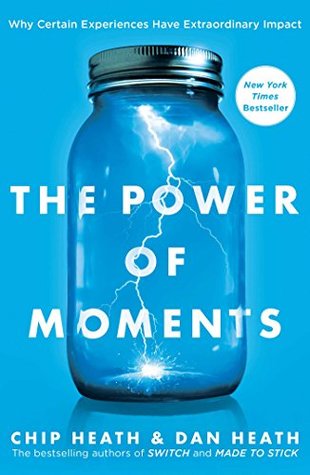More on this book
Community
Kindle Notes & Highlights
by
Chip Heath
Started reading
August 1, 2018
they tend to forget or ignore its length—a phenomenon called “duration neglect.”
Instead, they seem to rate the experience based on two key moments: (1) the best or worst moment, known as the “peak”; and (2) the ending. Psychologists call it the “peak-end rule.”
For the sake of this book, a defining moment is a short experience that is both memorable and meaningful. (“Short”
ELEVATION: Defining moments rise above the everyday. They provoke not just transient happiness, like laughing at a friend’s joke, but memorable delight.
To construct elevated moments, we must boost sensory pleasures—the
and, if appropriate, add an element of surprise. We’ll
INSIGHT: Defining moments rewire our understanding of ourselves or the world. In a few seconds or minutes, we realize something that might influence our lives for decades: Now
PRIDE: Defining moments capture us at our best—moments of achievement, moments of courage.
CONNECTION: Defining moments are social: weddings, graduations, baptisms, vacations, work triumphs, bar and bat mitzvahs, speeches, sporting events.
Wherever your treasure chest is, its contents are likely to include the four elements we’ve been discussing: • ELEVATION: A love letter. A ticket stub. A well-worn T-shirt. Haphazardly colored cards from your kids that make you smile with delight. • INSIGHT: Quotes or articles that moved you. Books that changed your view of the world. Diaries that captured your thoughts. • PRIDE: Ribbons, report cards, notes of recognition, certificates, thank-yous, awards. (It just hurts, irrationally, to throw away a trophy.) • CONNECTION: Wedding photos. Vacation photos. Family photos. Christmas photos of
...more
We’ll explore three situations that deserve punctuation: transitions, milestones, and pits.
To think in moments is to be attuned to transitions and milestones as well as to a third type of experience: pits. Pits are the opposite of peaks. They are negative defining moments—moments of hardship or pain or anxiety.
Many people are thrust into their first managerial assignments without any training on giving feedback or motivating teams. What’s needed is a managerial rite of passage that combines celebration of the honor with, say, a week’s worth of shadowing and counseling by an experienced senior manager.
four key elements of memorable experiences: elevation, insight, pride, and connection.
Research suggests that when customers contact you because they’ve had problems with your product or service, you should focus on defense—that is, you should focus on efficiency and not try to “delight” them.)
Research has shown, again and again, that we tend to obsess about problems and negative information.
How do you build peaks? You create a positive moment with elements of elevation, insight, pride, and/or connection. We’ll
To elevate a moment, do three things: First, boost sensory appeal. Second, raise the stakes. Third, break the script. (Breaking the script means to violate expectations about an experience—the next chapter is devoted to the concept.) Moments of elevation need not have all three elements but most have at least two.
Boosting sensory appeal is about “turning up the vo...
This highlight has been truncated due to consecutive passage length restrictions.
Things look better or taste better or sound better or feel better than they usually do. Wed...
This highlight has been truncated due to consecutive passage length restrictions.
One simple diagnostic to gauge whether you’ve transcended the ordinary is if people feel the need to pull out their cameras. If
“We feel most comfortable when things are certain, but we feel most alive when they’re not.”


